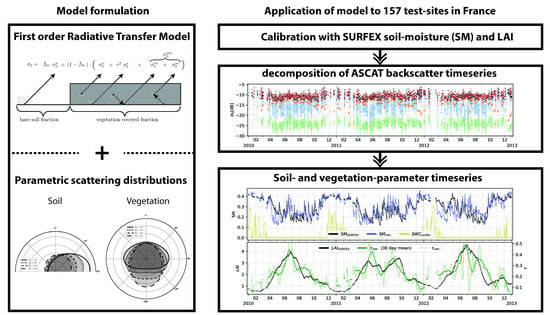A Generic First-Order Radiative Transfer Modelling Approach for the Inversion of Soil and Vegetation Parameters from Scatterometer Observations
Abstract
:1. Introduction
- All parameters except the optical depth of the vegetation layer () and the (nadir) hemispherical reflectance of the soil-surface (N) are assumed to remain temporally constant.
- A subset of parameters is chosen to represent the remaining spatial variability of the dataset that is not covered by variations in and N. Since the numerical values of those parameters can a priori only be restricted to a physically plausible range, the actual values for each scene are obtained by an optimization-procedure using inputs of auxiliary Leaf Area Index (LAI) (assumed to be ) and soil-moisture () (assumed to be ) timeseries provided by the Interactions between Soil, Biosphere, and Atmosphere (ISBA) land-surface model within the SURFEX modelling platform [12].
- The remaining (spatially and temporally constant) parameters are set based on empirical adjustments to achieve a reasonable agreement between ASCAT and modelled for the majority of processed points.
2. Materials and Methods
2.1. A Generic, Semi-Empirical Radiative Transfer Modelling Approach
2.1.1. Parametrization of Scattering Distribution Functions
| A: | (backward-peak) | B: | (upward-peak) | ||||
| C: | (downward-peak) | D: | (forward-peak) |
2.1.2. Vegetation Scattering Phase Function
2.1.3. Parametrization of the Bidirectional Reflectance Distribution Function ()
- The overall shape of the is represented by a peak oriented in specular direction whose width is related to the effective roughness and texture of the surface. The term effective is hereby used to indicate that aside of soil-characteristics, also topography as well as other land-cover classes (urban areas, water-bodies …) within the observed scene are implicitly subsumed in those parameters.
- In contrast to the scattering-pattern used for representing the vegetation-coverage, the behaviour of Fresnel’s reflection coefficients indicate that the amount of scattered radiation in specular direction originating from a (perfectly smooth) surface has a complex (polarization dependent) incidence-angle behaviour. A similar behaviour is expected to be observed when considering the scattering pattern of a rough surface.
- A must be normalized according to [18]:where denotes the directional hemispherical reflectance.
2.2. Dataset Description
2.2.1. ASCAT Backscattering Timeseries
- Frequency: C-band (5.225 GHz)
- Polarization: vertical (transmission and reception)
- Swath grid sampling resolution: 12.5 km
- Revisit time: ∼1–2 days
- Antenna look angles: ∼25° to ∼65°
2.2.2. Auxiliary SM and LAI Datasets
3. Choice of Parametrization
- (1)
- forward-simulation of ASCAT timeseries using auxiliary and datasets
- (2)
- inversion using auxiliary datasets
- (3)
- inversion using auxiliary datasets
- (4)
- simultaneous and inversion
3.1. Connection to Biophysical Variables
- The range of the parameter is constrained by ensuring that the resulting range of N remains physically plausible. Reported estimates of vertically polarized directional emissivity at similar frequencies [32,33,34] (which can be related to the directional hemispherical reflectivity via Kirchhoffs law [35] ) suggest a range of . Based on the reference-dataset, the range for is set to , and therefore the boundaries for within the fit-procedure were set to .
3.2. Numerical Value of the Single Scattering Albedo
3.3. Choice of a Vegetation Scattering Phase Function
3.4. Choice of a Surface BRDF
3.5. Effective Bare Soil Fraction
- In case is too large, a change in the vegetation-parameters will have a rather small impact on the calculated , and consequently the obtained vegetation-parameter-estimates from the fit-procedure are very likely to show ambiguity
- If however a sufficient amount of vegetation-contribution is necessary in order to adequately represent the incidence-angle behaviour of the provided dataset, an increase in can be compensated by simultaneously increasing . Under certain circumstances this behaviour can lead to a chain-reaction within the fit-procedure that will drive both and to its maximally allowed value.
3.6. Fit-Procedure
3.7. Incorporation of Auxiliary Datasets
4. Results and Discussion
- High is generally observed in mountainous regions which also show high percentage of freezing-periods throughout the year. Therefore, a high percentage of the data is masked during processing, which results in a distortion (or disappearance) of the seasonality within the timeseries.
- A measurement of a scene with high represents an average of reflections originating from strongly fluctuating topographies. Since is highly dependent on the incidence-angle , the obtained pair of (, )-values is consequently hardly representative for the actual measurement.
- The topmost soil-layer sensitive to C-band microwave observations in fact exhibits lower values during Spring compared to the SURFEX reference dataset.
- The retrieval of low values is actually caused by structural changes in the scattering behaviour of the vegetation-coverage (or the soil-layer) which have not been accounted for in the used model parametrization.
5. Conclusions
Author Contributions
Funding
Conflicts of Interest
Abbreviations
| ASCAT | Advamced Scatterometer |
| ISBA | Interactions between Soil, Biosphere and Atmosphere land-surface model |
| SURFEX | Surface Externalisée (in French), (a surface modelling platform developed by Météo-France) |
| BF | Broadleaf Forest |
| CF | Coniferous Forest |
| SC | Straw Cereals |
| GR | Grasslands |
| (incident, scattered) intensity | |
| Normalized backscattering coefficient (see (1) and [54]) | |
| contribution originating from bare soil scattering | |
| contribution originating from scattering events within the vegetation-layer | |
| 1st order scattering contribution to (vegetation-layer → soil-surface → detector) | |
| 1st order scattering contribution to (soil-surface → vegetation-layer → detector) | |
| 1st order interaction-contribution | |
| () | (generalized) scattering angle (see (5) and (6)) |
| polar zenith-angle (of incident, scattered radiation) in a spherical coordinate system | |
| azimuth-angle (of incident, scattered radiation) in a spherical coordinate system | |
| Optical depth (see [11]) | |
| Single scattering albedo (see [11]) | |
| 2-way attenuation factor | |
| Volume-scattering phase-function (see Section 2.1.2) | |
| Bidirectional reflectance distribution function (see Section 2.1.3) | |
| Hemispherical Reflectance (see (9)) | |
| t | Asymmetry-factor of the used -representation (see (9)) |
| Leaf area index | |
| Scaling factor between and (see (12)) | |
| Volumetric soil-moisture content | |
| N | Nadir hemispherical reflectance of defined in Section 2.1.3 |
| Scaling factor between N and (see (13)) | |
| Effective bare-soil fraction (see Section 2.1 and Section 3.5) | |
| Henyey-Greenstein function (see (3)) | |
| (squared) Pearson correlation coefficient | |
| Topographic complexity (see Appendix A) |
Appendix A. Topographic Complexity (ctopo)
References
- Karthikeyan, L.; Pan, M.; Wanders, N.; Kumar, D.N.; Wood, E.F. Four decades of microwave satellite soil moisture observations: Part 1. A review of retrieval algorithms. Adv. Water Resour. 2017, 109, 106–120. [Google Scholar] [CrossRef]
- Woodhouse, I.; Hoekman, D. Determining land-surface parameters from ERS wind scatterometer. IEEE Trans. Geosci. Remote Sens. 2000, 2000. 38, 126–140. [Google Scholar] [CrossRef]
- Bartalis, Z.; Naeimi, V.; Hasenauer, S.; Wagner, W. ASCAT Soil Moisture Product Handbook; ASCAT Soil Moisture Report Series, No. 15; Institute of Photogrammetry and Remote Sensing, Vienna University of Technolog: Vienna, Austria, 2008. [Google Scholar]
- Pulliainen, J.T.; Heiska, K.; Hyyppa, J.; Hallikainen, M.T. Backscattering properties of boreal forests at the C-and X-bands. IEEE Trans. Geosci. Remote Sens. 1994, 32, 1041–1050. [Google Scholar] [CrossRef]
- Toure, A.; Thomson, K.P.; Edwards, G.; Brown, R.J.; Brisco, B.G. Adaptation of the MIMICS backscattering model to the agricultural context-wheat and canola at L and C bands. IEEE Trans. Geosci. Remote Sens. 1994, 32, 47–61. [Google Scholar] [CrossRef]
- Eom, H.; Fung, A. A scatter model for vegetation up to Ku-band. Remote Sens. Environ. 1984, 15, 185–200. [Google Scholar] [CrossRef]
- Álvarez-Pérez, J.L. An extension of the IEM/IEMM surface scattering model. Waves Random Media 2001, 11, 307–329. [Google Scholar] [CrossRef]
- Álvarez-Pérez, J.L. The IEM2M rough-surface scattering model for complex-permittivity scattering media. Waves Random Complex Media 2012, 22, 207–233. [Google Scholar] [CrossRef]
- Dobson, M.; Ulaby, F. Active Microwave Soil Moisture Research. IEEE Trans. Geosci. Remote Sens. 1986, GE-24, 23–36. [Google Scholar] [CrossRef]
- Attema, E.P.W.; Ulaby, F.T. Vegetation modeled as a water cloud. Radio Sci. 1978, 13, 357–364. [Google Scholar] [CrossRef]
- Quast, R.; Wagner, W. Analytical solution for first-order scattering in bistatic radiative transfer interaction problems of layered media. Appl. Opt. 2016, 55, 5379–5386. [Google Scholar] [CrossRef]
- Masson, V.; Le Moigne, P.; Martin, E.; Faroux, S.; Alias, A.; Alkama, R.; Belamari, S.; Barbu, A.; Boone, A.; Bouyssel, F.; et al. The SURFEXv7.2 land and ocean surface platform for coupled or offline simulation of earth surface variables and fluxes. Geosci. Model Dev. 2013, 6, 929–960. [Google Scholar] [CrossRef] [Green Version]
- Henyey, L.G.; Greenstein, J.L. Diffuse radiation in the Galaxy. Astrophys. J. 1941, 93, 70–83. [Google Scholar] [CrossRef]
- Quast, R.I. Investigation of First-Order Corrections in Bistatic Radiative Transfer Models for Remote Sensing of Vegetated Terrain. Master’s Thesis, TU Wien, Vienna, Austria, 2017. [Google Scholar]
- Lafortune, E.; Foo, S.; Torrance, K.; Greenberg, D. Non-Linear Approximation of Reflectance Functions. In Proceedings of the SIGGRAPH’97 Conference, Los Angeles, California, USA, 3–8 August 1997; pp. 117–126. [Google Scholar]
- De Matthaeis, P.; Lang, R.H. Microwave scattering models for cylindrical vegetation components. Prog. Electromagn. Res. 2005, 55, 307–333. [Google Scholar] [CrossRef]
- Olver, F.W.J.; Olde Daalhuis, A.B.; Lozier, D.W.; Schneider, B.I.; Boisvert, R.F.; Clark, C.W.; Miller, B.R.; Saunders, B.V. (Eds.) NIST Digital Library of Mathematical Functions; NIST: Washington, DC, USA, 2018. Available online: http://dlmf.nist.gov/ (accessed on 27 March 2018).
- Nicodemus, F.E.; Richmond, J.C.; Hsia, J.J.; Ginsberg, I.W.; Limperis, T. Geometric Considerations and Nomenclature for Reflectance; National Bureau of Standards: Washington, DC, USA, 1977.
- Figa-Saldaña, J.; Wilson, J.J.; Attema, E.; Gelsthorpe, R.; Drinkwater, M.R.; Stoffelen, A. The advanced scatterometer (ASCAT) on the meteorological operational (MetOp) platform: A follow on for European wind scatterometers. Can. J. Remote Sens. 2002, 28, 404–412. [Google Scholar] [CrossRef]
- Noilhan, J.; Planton, S. A simple parameterization of land surface processes for meteorological models. Mon. Weather Rev. 1989, 117, 536–549. [Google Scholar] [CrossRef]
- Noilhan, J.; Mahfouf, J.F. The ISBA land surface parameterisation scheme. Glob. Planet. Chang. 1996, 13, 145–159. [Google Scholar] [CrossRef]
- Durand, Y.; Brun, E.; Mérindol, L.; Guyomarc’h, G.; Lesaffre, B.; Martin, E. A meteorological estimation of relevant parameters for snow models. Ann. Glaciol. 1993, 18, 65–71. [Google Scholar] [CrossRef]
- Quintana-Segui, P.; Le Moigne, P.; Durand, Y.; Martin, E.; Habets, F.; Baillon, M.; Canellas, C.; Franchisteguy, L.; Morel, S. Analysis of near-surface atmospheric variables: Validation of the SAFRAN analysis over France. J. Appl. Meteorol. Climatol. 2008, 47, 92–107. [Google Scholar] [CrossRef]
- Calvet, J.C.; Noilhan, J.; Roujean, J.L.; Bessemoulin, P.; Cabelguenne, M.; Olioso, A.; Wigneron, J.P. An interactive vegetation SVAT model tested against data from six contrasting sites. Agric. For. Meteorol. 1998, 92, 73–95. [Google Scholar] [CrossRef]
- Gibelin, A.L.; Calvet, J.C.; Roujean, J.L.; Jarlan, L.; Los, S.O. Ability of the land surface model ISBA-A-gs to simulate leaf area index at the global scale: Comparison with satellites products. J. Geophys. Res. Atmos. 2006, 111. [Google Scholar] [CrossRef] [Green Version]
- Boone, A.; Calvet, J.C.; Noilhan, J. Inclusion of a third soil layer in a land surface scheme using the force–restore method. J. Appl. Meteorol. 1999, 38, 1611–1630. [Google Scholar] [CrossRef]
- Faroux, S.; Tchuenté, A.K.; Roujean, J.L.; Masson, V.; Martin, E.; Le Moigne, P. ECOCLIMAP-II/Europe: A twofold database of ecosystems and surface parameters at 1 km resolution based on satellite information for use in land surface, meteorological and climate models. Geosci. Model Dev. 2013, 6, 563. [Google Scholar] [CrossRef]
- Laanaia, N.; Carrer, D.; Calvet, J.C.; Pagé, C. How will climate change affect the vegetation cycle over France? A generic modeling approach. Clim. Risk Manag. 2016, 13, 31–42. [Google Scholar] [CrossRef] [Green Version]
- Albergel, C.; Calvet, J.C.; de Rosnay, P.; Balsamo, G.; Wagner, W.; Hasenauer, S.; Naeimi, V.; Martin, E.; Bazile, E.; Bouyssel, F.; et al. Cross-evaluation of modelled and remotely sensed surface soil moisture with in situ data in southwestern France. Hydrol. Earth Syst. Sci. 2010, 14, 2177–2191. [Google Scholar] [CrossRef] [Green Version]
- Draper, C.; Mahfouf, J.F.; Calvet, J.C.; Martin, E.; Wagner, W. Assimilation of ASCAT near-surface soil moisture into the SIM hydrological model over France. Hydrol. Earth Syst. Sci. 2011, 15, 3829–3841. [Google Scholar] [CrossRef] [Green Version]
- Calvet, J.C.; Fritz, N.; Berne, C.; Piguet, B.; Maurel, W.; Meurey, C. Deriving pedotransfer functions for soil quartz fraction in southern France from reverse modeling. SOIL 2016, 2, 615–629. [Google Scholar] [CrossRef] [Green Version]
- Ringerud, S.; Kummerow, C.; Peters-Lidard, C.; Tian, Y.; Harrison, K. A Comparison of Microwave Window Channel Retrieved and Forward-Modeled Emissivities Over the U.S. Southern Great Plains. IEEE Trans. Geosci. Remote Sens. 2014, 52, 2395–2412. [Google Scholar] [CrossRef]
- Vittucci, C.; Guerriero, L.; Ferrazzoli, P.; Rahmoune, R.; Barraza, V.; Grings, F. Study of multifrequency sensitivity to soil moisture variations in the lower Bermejo basin. Eur. J. Remote Sens. 2013, 46, 775–788. [Google Scholar] [CrossRef]
- Monerris, A.; Camps, A.; Vall-llossera, M. Empirical determination of the soil emissivity at L-band: Effects of soil moisture, soil roughness, vine canopy, and topography. In Proceedings of the 2007 IEEE International Geoscience and Remote Sensing Symposium, Barcelona, Spain, 23–27 July 2007; pp. 1110–1113. [Google Scholar] [CrossRef]
- Nicodemus, F.E. Directional Reflectance and Emissivity of an Opaque Surface. Appl. Opt. 1965, 4, 767–775. [Google Scholar] [CrossRef]
- Grant, J.; Wigneron, J.P.; Jeu, R.D.; Lawrence, H.; Mialon, A.; Richaume, P.; Bitar, A.A.; Drusch, M.; van Marle, M.; Kerr, Y. Comparison of SMOS and AMSR-E vegetation optical depth to four MODIS-based vegetation indices. Remote Sens. Environ. 2016, 172, 87–100. [Google Scholar] [CrossRef]
- Liu, Y.Y.; de Jeu, R.A.M.; McCabe, M.F.; Evans, J.P.; van Dijk, A.I.J.M. Global long-term passive microwave satellite-based retrievals of vegetation optical depth. Geophys. Res. Lett. 2011, 38. [Google Scholar] [CrossRef] [Green Version]
- Konings, A.G.; Piles, M.; Das, N.; Entekhabi, D. L-band vegetation optical depth and effective scattering albedo estimation from SMAP. Remote Sens. Environ. 2017, 198, 460–470. [Google Scholar] [CrossRef]
- Van de Griend, A.A.; Wigneron, J.P. On the measurement of microwave vegetation properties: Some guidelines for a protocol. IEEE Trans. Geosci. Remote Sens. 2004, 42, 2277–2289. [Google Scholar] [CrossRef]
- Ferrazzoli, P.; Guerriero, L.; Wigneron, J.P. Simulating L-band emission of forests in view of future satellite applications. IEEE Trans. Geosci. Remote Sens. 2002, 40, 2700–2708. [Google Scholar] [CrossRef]
- Xie, Y.; Shi, J.; Lei, Y.; Li, Y. Modeling Microwave Emission from Short Vegetation-Covered Surfaces. Remote Sens. 2015, 7, 14099–14118. [Google Scholar] [CrossRef] [Green Version]
- Liao, T.H.; Kim, S.B.; Tan, S.; Tsang, L.; Su, C.; Jackson, T.J. Multiple scattering effects with cyclical correction in active remote sensing of vegetated surface using vector radiative transfer theory. IEEE J. Sel. Top. Appl. Earth Obs. Remote Sens. 2016, 9, 1414–1429. [Google Scholar] [CrossRef]
- Kurum, M. Quantifying scattering albedo in microwave emission of vegetated terrain. Remote Sens. Environ. 2013, 129, 66–74. [Google Scholar] [CrossRef]
- Parrens, M.; Al Bitar, A.; Mialon, A.; Fernandez-Moran, R.; Ferrazzoli, P.; Kerr, Y.; Wigneron, J.P. Estimation of the L-band Effective Scattering Albedo of Tropical Forests using SMOS observations. IEEE Geosci. Remote Sens. Lett. 2017, 14, 1223–1227. [Google Scholar] [CrossRef]
- Kurum, M.; O’Neill, P.E.; Lang, R.H.; Joseph, A.T.; Cosh, M.H.; Jackson, T.J. Effective tree scattering at L-band. In Proceedings of the 2011 IEEE International Geoscience and Remote Sensing Symposium (IGARSS), Vancouver, BC, Canada, 24–29 July 2011; pp. 1036–1039. [Google Scholar]
- Kurum, M.; O’Neill, P.; Lang, R. Effective albedo of vegetated terrain at L-band. In Proceedings of the 2012 12th Specialist Meeting on Microwave Radiometry and Remote Sensing of the Environment (MicroRad), Rome, Italy, 5–9 March 2012; pp. 1–4. [Google Scholar] [CrossRef]
- Kurum, M.; O’Neill, P.E.; Lang, R.H.; Joseph, A.T.; Cosh, M.H.; Jackson, T.J. Effective tree scattering and opacity at L-band. Remote Sens. Environ. 2012, 118, 1–9. [Google Scholar] [CrossRef] [Green Version]
- Graham, A.; Harris, R. Extracting biophysical parameters from remotely sensed radar data: A review of the water cloud model. Prog. Phys. Geogr. 2003, 27, 217–229. [Google Scholar] [CrossRef]
- Jones, E.; Oliphant, T.; Peterson, P. SciPy: Open Source Scientific Tools for Python. 2001. Available online: http://www.scipy.org/ (accessed on 30 January 2019).
- Branch, M.A.; Coleman, T.F.; Li, Y. A Subspace, Interior, and Conjugate Gradient Method for Large-Scale Bound-Constrained Minimization Problems. SIAM J. Sci. Comput. 1999, 21, 1–23. [Google Scholar] [CrossRef] [Green Version]
- Meurer, A.; Smith, C.P.; Paprocki, M.; Čertík, O.; Kirpichev, S.B.; Rocklin, M.; Kumar, A.; Ivanov, S.; Moore, J.K.; Singh, S.; et al. SymPy: Symbolic computing in Python. PeerJ Comput. Sci. 2017, 3, e103. [Google Scholar] [CrossRef]
- Van der Walt, S.; Colbert, S.C.; Varoquaux, G. The NumPy Array: A Structure for Efficient Numerical Computation. Comput. Sci. Eng. 2011, 13, 22–30. [Google Scholar] [CrossRef] [Green Version]
- More, J. The Levenberg-Marquardt Algorithm: Implementation and Theory; Springer: Berlin/Heidelberg, Germany, 1977. [Google Scholar] [CrossRef]
- Tomiyasu, K. Relationship between and measurement of differential scattering coefficient (σ0) and bidirectional reflectance distribution function (BRDF). IEEE Trans. Geosci. Remote Sens. 1988, 26, 660–665. [Google Scholar] [CrossRef]
- EUMETSAT. ASCAT Product Handbook (EUM/OPS-EPS/MAN/04/0028, v5); EUMETSAT: Darmstadt, Germany, 2015. [Google Scholar]

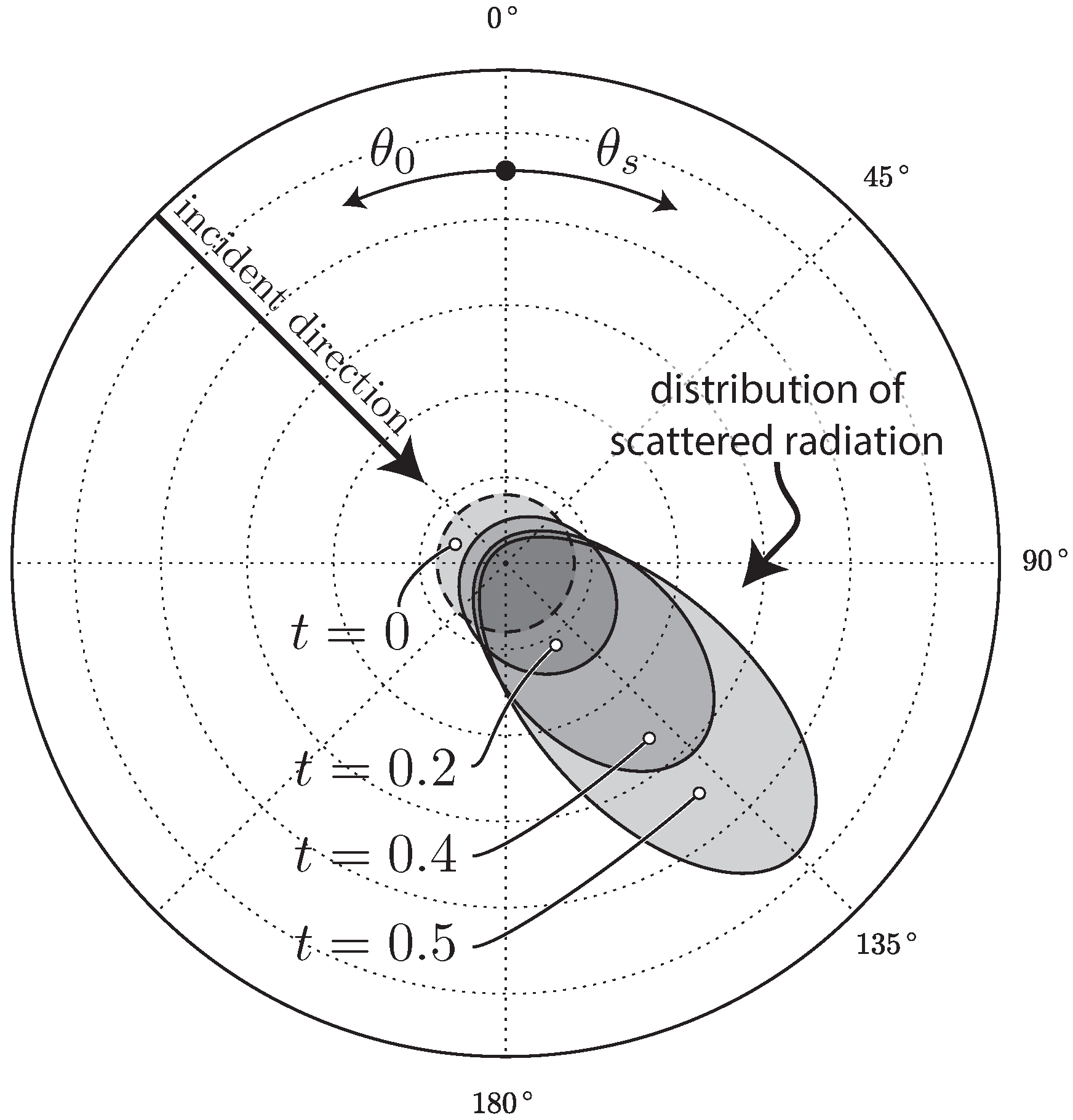


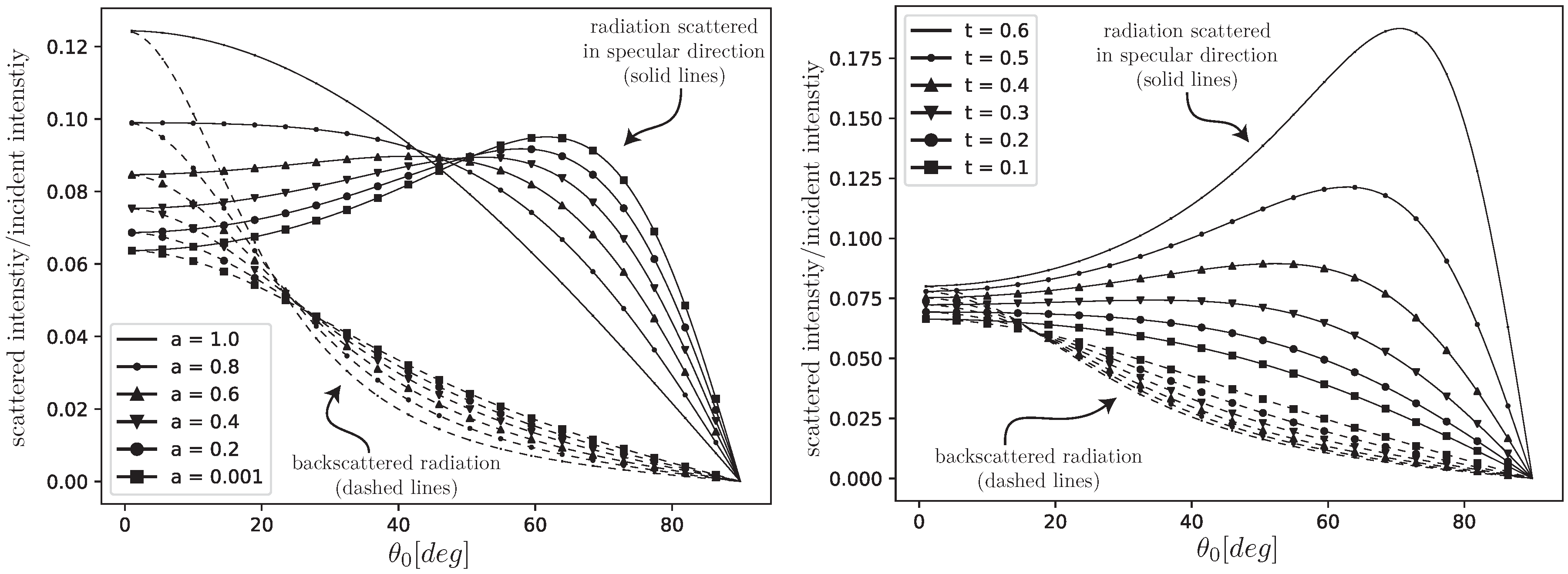
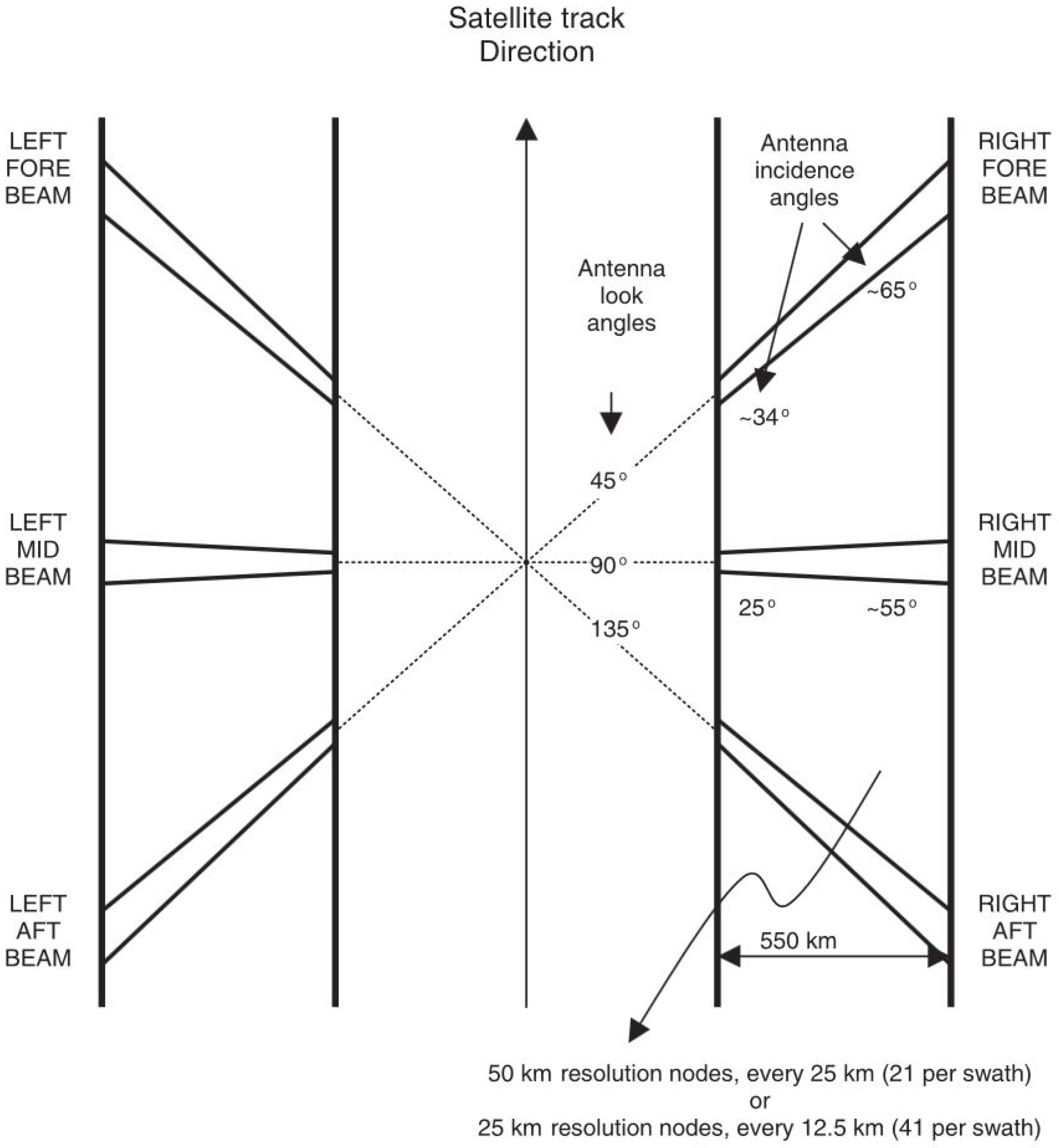

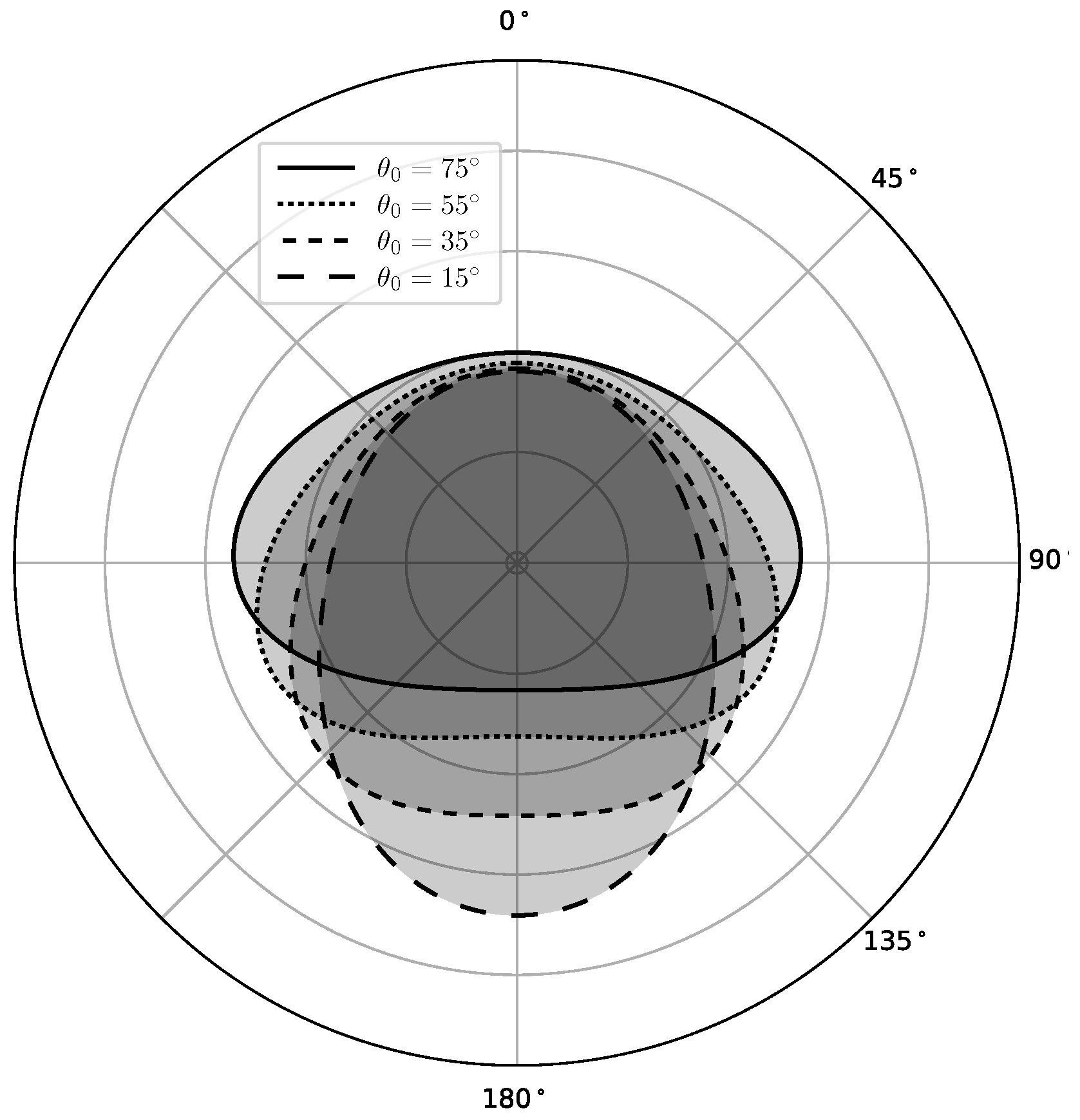


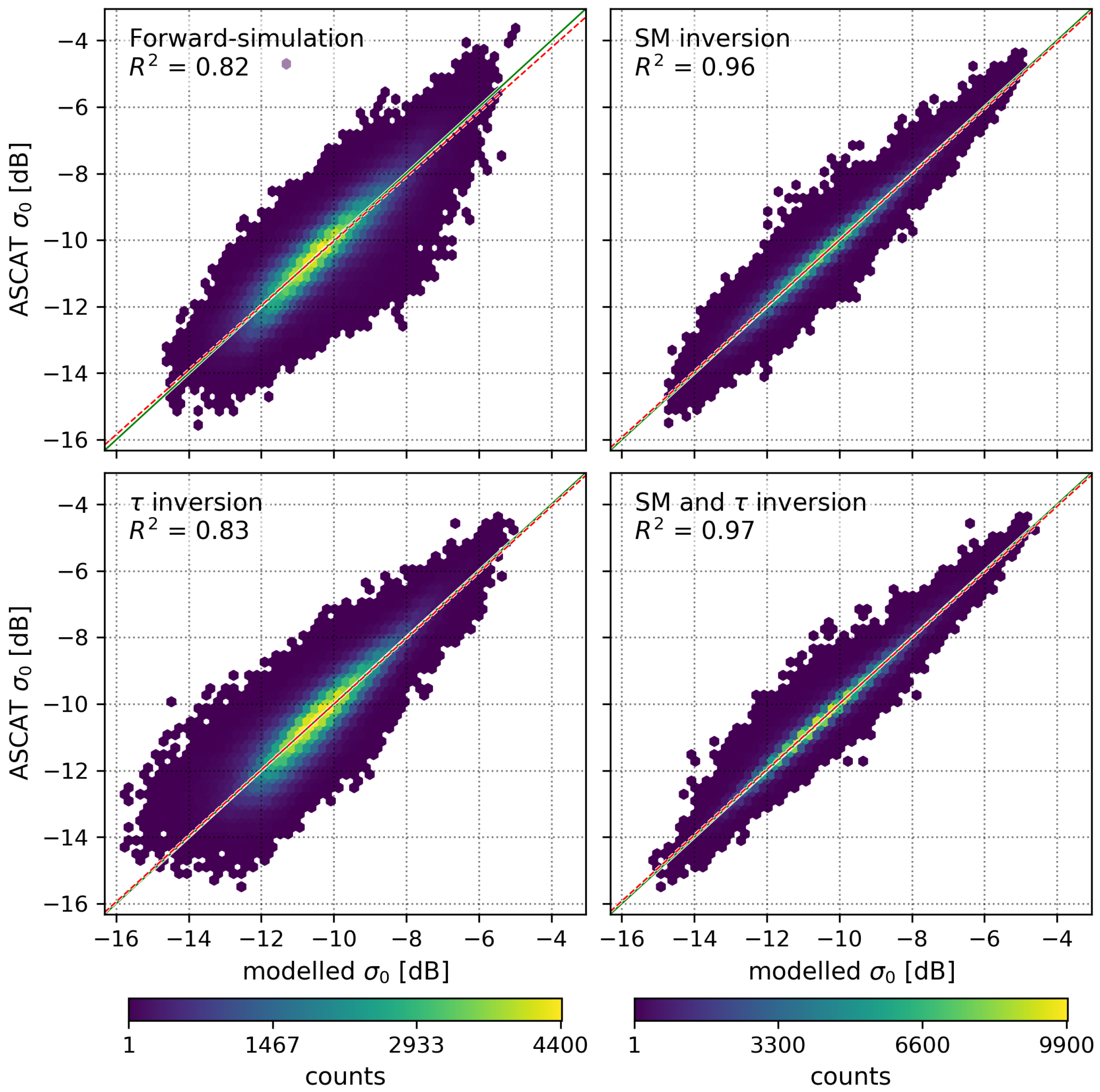


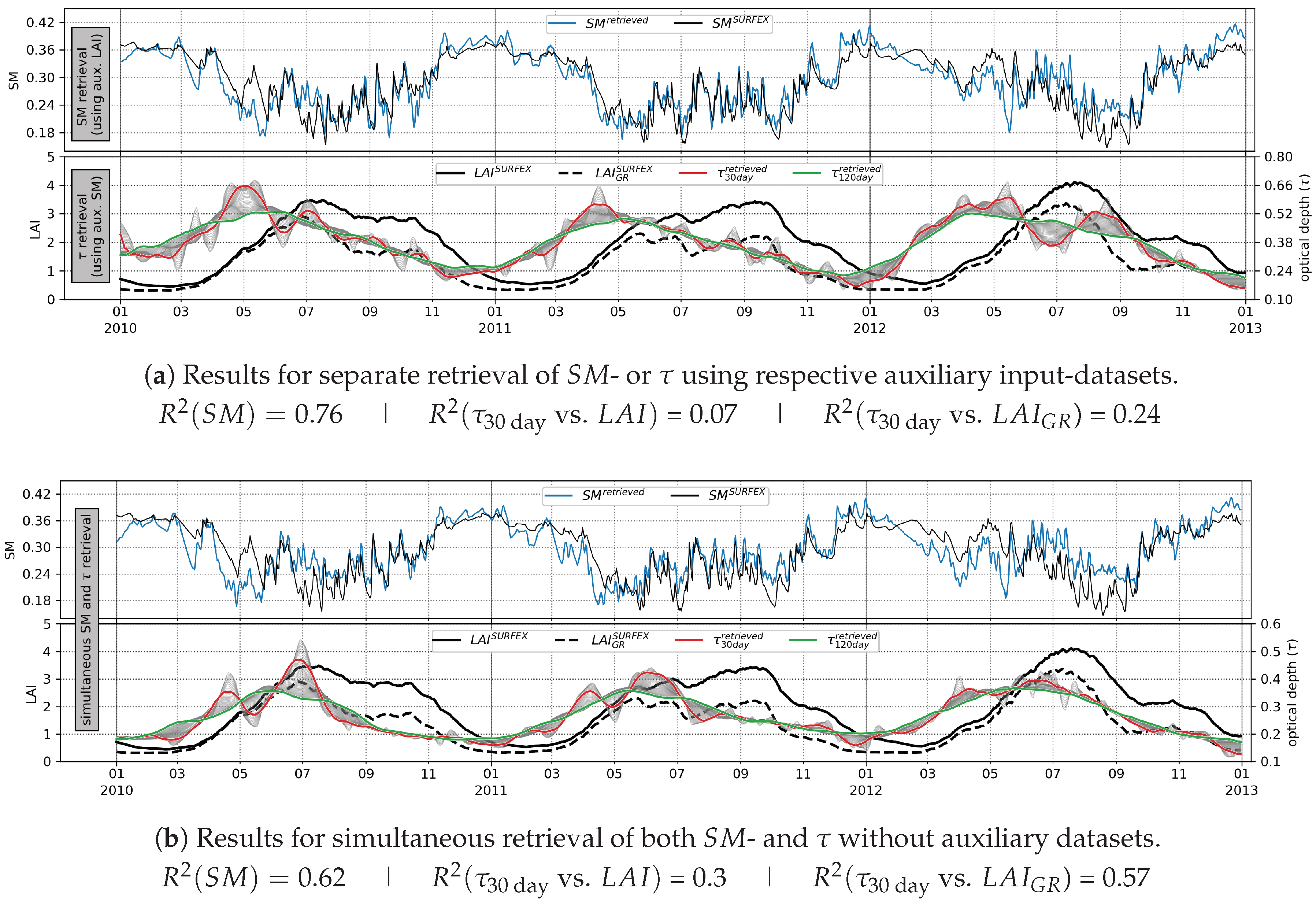


© 2019 by the authors. Licensee MDPI, Basel, Switzerland. This article is an open access article distributed under the terms and conditions of the Creative Commons Attribution (CC BY) license (http://creativecommons.org/licenses/by/4.0/).
Share and Cite
Quast, R.; Albergel, C.; Calvet, J.-C.; Wagner, W. A Generic First-Order Radiative Transfer Modelling Approach for the Inversion of Soil and Vegetation Parameters from Scatterometer Observations. Remote Sens. 2019, 11, 285. https://doi.org/10.3390/rs11030285
Quast R, Albergel C, Calvet J-C, Wagner W. A Generic First-Order Radiative Transfer Modelling Approach for the Inversion of Soil and Vegetation Parameters from Scatterometer Observations. Remote Sensing. 2019; 11(3):285. https://doi.org/10.3390/rs11030285
Chicago/Turabian StyleQuast, Raphael, Clément Albergel, Jean-Christophe Calvet, and Wolfgang Wagner. 2019. "A Generic First-Order Radiative Transfer Modelling Approach for the Inversion of Soil and Vegetation Parameters from Scatterometer Observations" Remote Sensing 11, no. 3: 285. https://doi.org/10.3390/rs11030285




